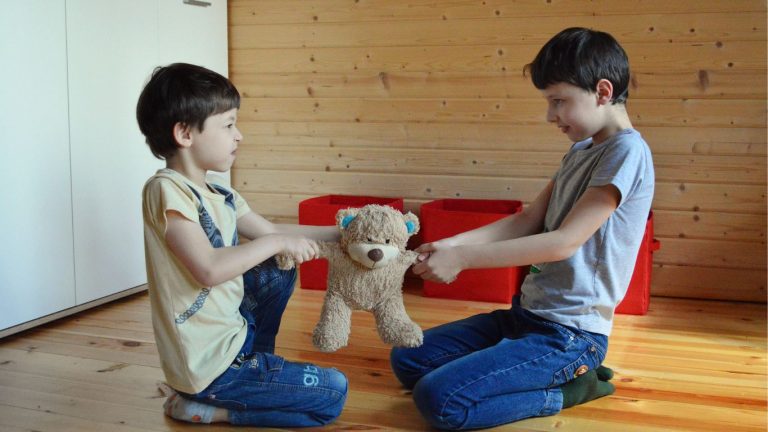As a nutritionist who is passionate about food, I believe the joy of food, and a healthy relationship with food, is something all children should experience. Teaching kids to develop healthy food options is something parents can do to foster that healthy relationship.
Helping your children learn that by eating a balanced diet they’ll have more energy for playing, sleep better and grow into big people who don’t get sick easily, you’ll be growing strong, healthy little people with positive attitudes toward feeding their bodies that will last them a lifetime.
Ideas for teaching kids to develop healthy food options
Below are a few ideas to help develop healthy attitudes toward food and ultimately make eating fun!
Teach them the why
Did you know you need protein (such as meat, cheese and beans) to build muscles, calcium for strong teeth and bones, fruit and veggies to make you smart, as well as carbohydrates for energy? Well of course you do. But do your little ones understand this?
From as early as the age of 2 you can start to introduce ideas that food is important for growing, having energy and learning.
I was amazed at how my nephew responded to this and now regularly says to me,
it’s important I eat my yoghurt, so I can grow up to be big and strong isn’t it Aunty Kate?
The fact he now understands that what he puts into his body has implications for how his body works, is the fundamentals of a positive attitude toward food. He’ll carry this attitude with him throughout his life and hopefully teach his children too.
Statements such as ‘one bite of broccoli will help you grow into a big boy so you can start kindy’ or ‘this pasta is going to give you so much energy for swimming tomorrow, we’d better eat some more’ start to develop an association with good eating habits.
You’ll even find that helping them understand why lots of coloured, high sugar or high salt foods are not good for their bodies all the time catches on.
Presenting fun food
Presentation can make all the difference between whether or not a child will eat food – particularly for those not so exciting foods.
Serving foods in funky dishes can encourage consumption as it makes eating fun. Little minds love to be creative and stimulated. Use a fun and colourful drink bottle to encourage the drinking of water and a gorgeous lunch box to make home packed healthy lunches fun.
Also you can try cutting food into fun shapes – use sandwich cutters or a knife to cut into squares, circles and triangles.
Make fruit kebabs using straws or put veggies, hummus, and cottage cheese into different bowls and let your child choose what and how they wish to eat it.
Encourage your children to take responsibility
Food should not only be fun but also be about more than just eating. By this I mean think beyond that last step in the process – the eating.
It’s about educating and empowering your children with knowledge about food and healthy attitudes, which they’ll carry throughout life. Children can be involved in all aspects of food from growing plants/food, preparing dishes, cooking, setting the table and cleaning up.
By involving children in the preparation and cooking of meals, you help stimulate an interest in food and improve the likelihood of your child eating the meal. I know it isn’t realistic to think you have time in today’s hectic world to let your kids help cook dinner every night. Just choose a routine that works for you – be it once a week or even once a month. It all helps.
Food preparation offers great learning opportunities, socialisation and gives children an appreciation for food. Simple meals that children can create themselves are great such as pizzas and tacos.
A safety step, funky place mats and utensils designed just for children make them feel involved throughout the process and enhances the experience for a child. Let children serve themselves and determine their own meal size. A healthy child is the best judge of how much they should eat.
Children have built in hunger and satiety cues, which determine their appetite. By letting them decide on their own meal size you’re ensuring they’re in tune with their natural appetite and requirements. Plates made just for children are a great way to guide children’s serving sizes. Don’t worry – children generally eat when they’re hungry and won’t starve themselves!
Lots of positive reinforcement
Acknowledge good behaviours and ignore the bad – avoid forcing or coercing a child to eat. Try to be calm, firm and consistent. Children watch what you eat and learn from your relationship with food.
Young children are more likely to want to eat the food their parents eat. As they get older, they tend to want the foods that their friends (and the kids in commercials) eat. So role modelling is one of the best ways to encourage your child to eat well, Monkey see-Monkey do and all that.
Avoid offering lots of alternatives if the prepared meal is refused too. You decide what’s on the menu. They may not be hungry. Remember children go through growth and activity spurts, so sometimes they’re really hungry, and sometimes they eat like birds.
As long as you offer nutritious food, you can trust your child’s appetite to get the balance right. Try to choose healthy snacks too – alternatives high in sugar, fat and salt (lollies, chips and cakes) interfere with their natural appetite for nutritious food. Let their appetite be the guide, and praise them like crazy when they help themselves to that apple!
 Variety, it’s the spice of life
Variety, it’s the spice of life
Introduce children to a range of tastes, textures and colours. To stay healthy and grow, it’s important young children eat a variety of different foods. Try to choose food not just from the four food groups, but also different foods within each food group, as they’re rich in different vitamins and minerals.
A banana for example is a great source of vitamin B, whereas an orange is a good source of vitamin C. But both sit within the same food group. Ensuring variety, both between, and within food groups, means you’re giving your child the greatest chance of getting a balanced and nutritious diet.
Children may need to be offered a new food 6-10 times before they taste it and, eventually, eat it. Keep offering a small amount of the food that your child has previously refused, as repeated tasting helps them to learn to accept new foods. It helps if they see their parents and peers eating them too!
A food reward chart is a fantastic tool to help raise your child’s awareness of new foods – it’s also a fabulous way to all be involved and helps to make eating fun. You can have rewards for eating everything in their lunch box, for trying 1 new food a week, or for eating 5 different fruit and veg in one day.
Making mealtime a routine
Set up a routine around mealtime so everyone knows what to expect. It helps to eat around the same time and commit time to eating – discourage rushing the meal to do other things.
The mealtime routine should be flexible and fun of course – try mixing it up a bit – a picnic at the beach or park, or outside if the weather’s fine. The aim is to foster a calm, friendly atmosphere – a stressful climate at mealtimes teaches children to regard mealtimes as an ordeal, not the fun, positive experience that it should be.
Consider that feeling hungry is partly determined by your child’s ‘stomach clock’ – how much they ate yesterday at the same time. Meals at regular times actually encourage a healthy appetite next mealtime.
You can use this to encourage children who under eat at mealtimes to eat more by limiting ‘grazing’ (or random snacking). On the other hand, regular healthy snacks can be a great way to reduce overeating at mealtimes. There’s a little bit of everything in moderation going on here. But a regular daily routine will go a long way to your child eating the right foods at the right time of day.
So do family mealtimes really make a difference? Well, research from Cornell University found your child:
- may be 35% less likely to engage in disordered eating
- 24% more likely to eat healthier foods, and
- 12% less likely to be overweight
Sociable and impressionable, small children benefit hugely by being included in the family meal. They’ll absorb everything from table manners to family dynamics, social skills to an open-minded attitude toward new food. If children observe siblings and adults eating a range of foods at family meals, they’ll be more likely to try it themselves.
Right from the start, try to encourage your toddler to sit down whenever they’re eating or drinking – its safer and lays the foundation for teaching the importance of making time for eating. Small children may not tolerate sitting down for an entire meal – but at least encourage them to eat what they wish sitting down and allow them to leave the table when they’ve finished.
Eating together as a family whenever you can also helps children understand and pick up a few table manners. The finer points of manners, for instance talking with their mouth full, or reaching over others probably won’t be grasped by children until they’re about 5 years old. But even children this young can begin learning their ‘Ps & Qs’. Learning table manners lays a foundation for teaching the importance of respect. We can be respectful to the person who prepared the meal, the farmers that grew the food, or even to the animals that we’re eating.
A Place for ALL food
As lovers of everything about food, my view on ‘junk food’ is a pragmatic one. If you want your child to have a ‘normal up-bringing’, avoiding junk food is almost impossible. So my approach is based on managing it and approaching it in moderation.
In my opinion, the biggest problem with junk food is the fact that generally it’s highly processed with large quantities of unknown additives, preservatives, and chemicals. ‘Junk’ food offers very little in terms of benefiting your child nutritionally, and is full of empty calories, which can contribute to weight and health problems.
The emphasis for parents should be to empower children with information and knowledge about food to allow them to make good life choices in relation to food. Keep it in perspective – there is no such thing as ‘BAD’ food! Some foods are healthier and should be eaten everyday, whilst other foods should only be eaten occasionally.
Make takeaways healthier by the choices you make – look for lower fat alternatives – kebabs, burgers, grilled fish, rice or noodle based dishes with veggies. Another alternative is to make homemade ‘takeaways’ – grilled fish and chips or homemade pizza with all your child’s favourite toppings.
Try a bit of home baking instead of always offering mass-produced biscuits and cakes that may contain trans-fats, colours and preservatives. You’ll save money too!
If you’re looking for more ideas for teaching kids to develop healthy food options, there’s some great books on family nutrition, for example Dr Libby’s Women’s Wellness Wisdom or Feed Your Brain by Delia McCabe. You’ll also want to check out our article on Optimum nutrition – how to eat the rainbow.








Great article, thanks 🙂